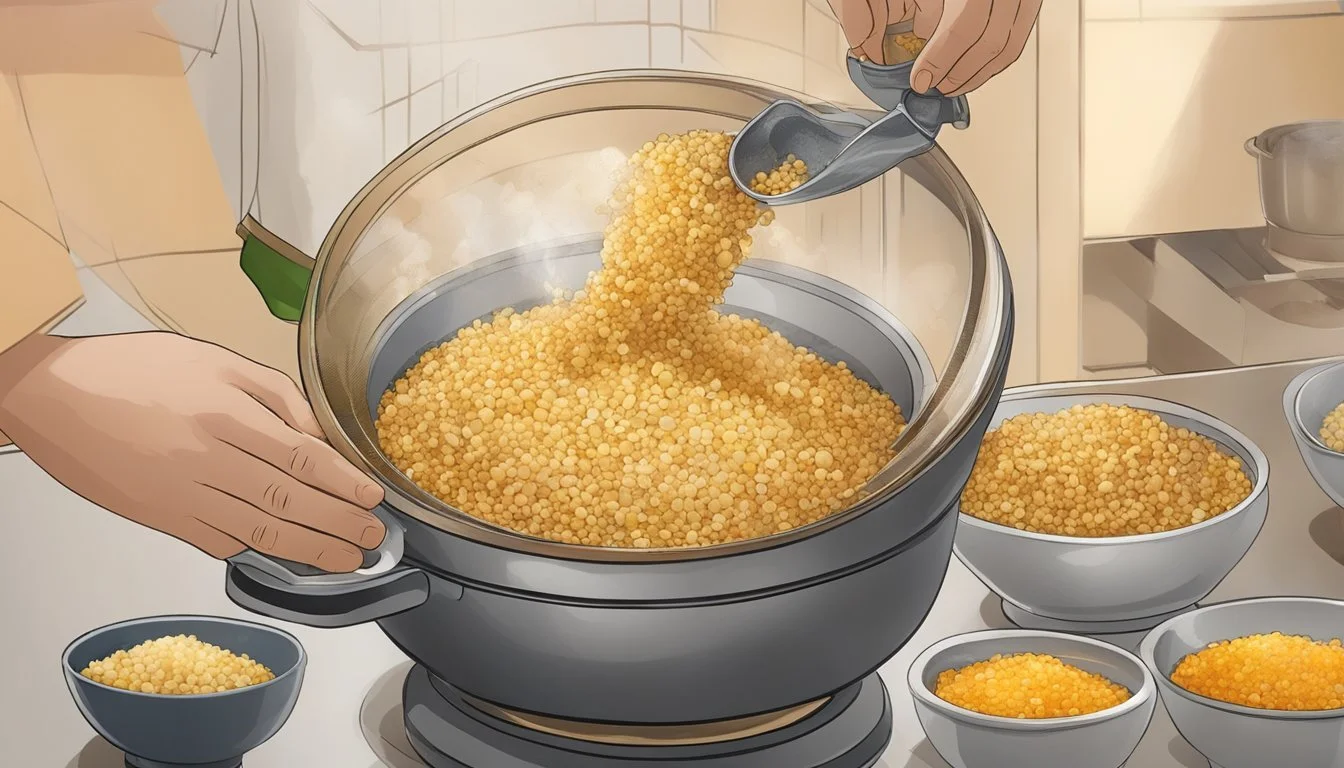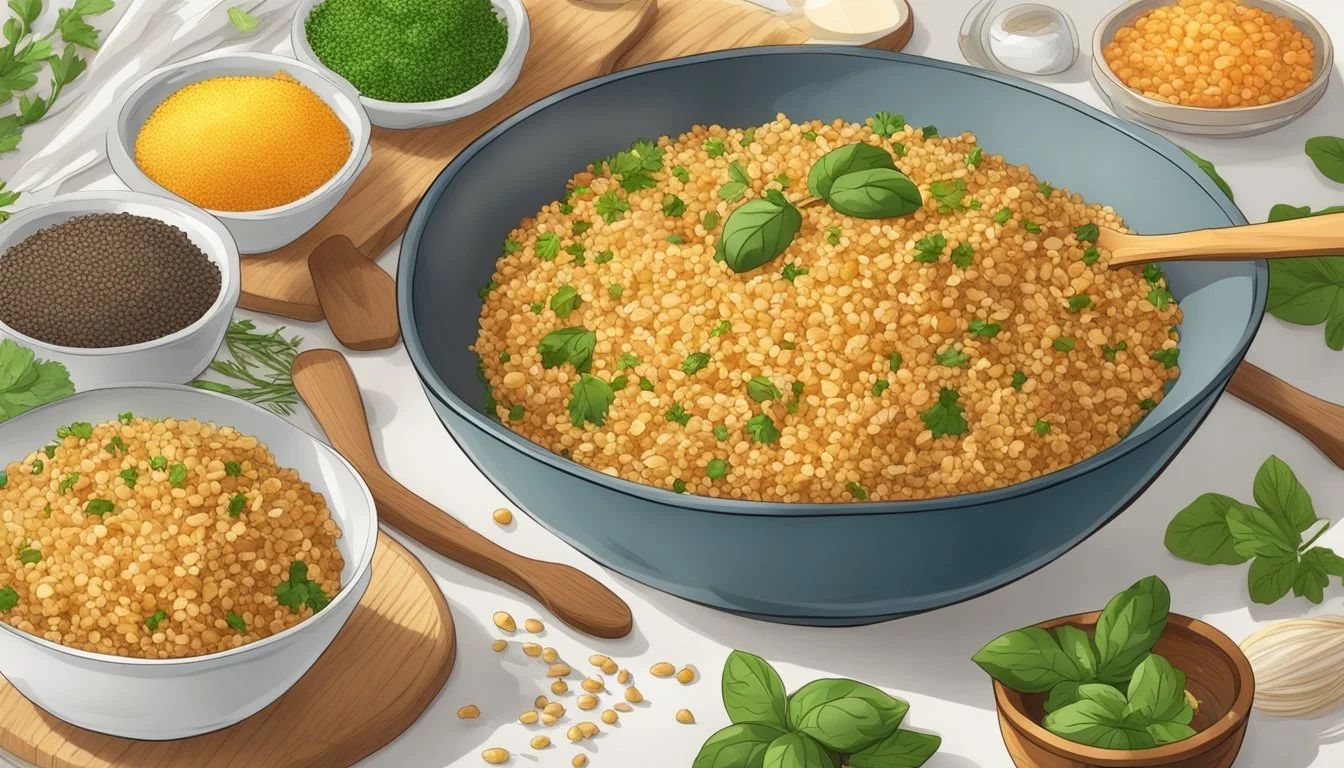How to Substitute Kasha for Bulgur in Pilafs
A Seamless Transition Guide
Kasha, also known as toasted buckwheat, is a highly versatile ingredient commonly used in Eastern European cuisine, particularly in pilafs. Its nutty flavor and distinctive texture make it an excellent alternative to bulgur, a kind of dried cracked wheat with a lighter flavor profile, widely used in Middle Eastern dishes. Though these grains originate from different cultural backgrounds, they share similarities in their ability to absorb flavors and maintain a firm yet chewable texture after cooking, which is essential for the integrity of a pilaf dish.
When substituting kasha for bulgur in pilafs, one should take into account the slight differences in cooking times and liquid absorption rates. Kasha tends to cook more quickly than bulgur, meaning that adjustments might be necessary to prevent overcooking. This substitution allows for an exploration of new flavors while still maintaining the general character of a traditional bulgur pilaf.
By incorporating kasha into your pilaf, you introduce a nutritious seed that is naturally gluten-free and rich in protein. With its robust flavor, kasha provides a new dimension to the pilaf, making it not just a substitute but also an elevation of the original dish. It is important to toast the kasha in a dry pan or with a little oil until it releases a nutty aroma before simmering it in stock or water, which imparts a depth of flavor akin to that of well-prepared bulgur.
Understanding Kasha
In the context of substituting kasha for bulgur in pilafs, it is essential to understand the fundamental differences between the two grains, especially in terms of origin, nutritional content, and texture.
Origins and Nutrition
Kasha originates from the buckwheat plant, which is not a cereal grain but a fruit seed related to rhubarb and sorrel. As such, kasha naturally aligns with a gluten-free diet, making it suitable for those with celiac disease or gluten intolerance. Nutritionally, kasha is a powerhouse, packed with protein, fiber, and a robust profile of minerals such as magnesium, iron, and various vitamins. It is often referred to as a pseudocereal for its grain-like characteristics and use in similar culinary applications.
Nutritional highlights of Kasha:
High in protein and fiber
Rich in minerals such as iron and magnesium
Abundant in vitamins
Suitable for gluten-free diets
Kasha vs Bulgur
Comparing kasha with bulgur, the latter is a form of whole wheat that has been cleaned, parboiled, dried, and then cracked into varying degrees of coarseness. Unlike kasha, bulgur does contain gluten and may not be suitable for those with gluten sensitivities. Although both grains contribute nutrients to the diet, kasha's gluten-free status and slightly higher content of certain minerals and vitamins give it a distinct advantage for those seeking these particular dietary requirements. The two grains differ in texture as well; kasha tends to be softer and more granular when cooked, while bulgur has a chewier feel and a more pronounced nutty flavor.
Texture comparisons:
Kasha: softer, more granular
Bulgur: chewier, nuttier flavor
When considering kasha as a substitute for bulgur, one should account for these textural differences to achieve a satisfactory pilaf outcome.
Examining Bulgur
Before learning about substituting kasha for bulgur in pilafs, it's essential to understand what bulgur is and its role in various dishes. Bulgur is a type of whole wheat grain that is often used in Mediterranean and Middle Eastern cuisines, recognized for its nutritional benefits, including being high in fiber and protein.
Types of Bulgur
Bulgur wheat is processed from the kernels of durum wheat. It comes in several different grinds or sizes, typically labeled as fine, medium, or coarse. The size affects both the texture and the cooking time of the bulgur.
Fine bulgur: This type often only needs to be soaked in hot water to be edible. It is commonly used in salads like tabbouleh.
Medium bulgur: A versatile size that is suitable for a variety of dishes, including pilafs and some baking applications.
Coarse bulgur: With its longer cooking time, coarse bulgur is preferred for dishes that require a heartier texture, such as kibbeh or as a rice substitute in pilafs.
Culinary Uses of Bulgur
In addition to its dietary benefits, bulgur wheat has a firm texture and a nutty flavor that makes it a suitable base ingredient for a wide array of dishes. It is a traditional element in many Mediterranean and Middle Eastern recipes.
Mediterranean Cuisine: Bulgur is a staple in Mediterranean kitchens, known for being the primary ingredient in tabbouleh salad.
Middle Eastern Cuisine: In Middle Eastern dishes, bulgur is used to create kibbeh and various forms of pilaf, showcasing its versatility in both cold and hot applications.
Nutritional Profile: Owing to its whole grain properties, bulgur is high in fiber and protein, making it a healthful choice for those seeking nutritious meal options.
Benefits of Substituting Kasha
Substituting kasha for bulgur in pilaf recipes offers both dietary advantages and interesting textural contrasts. It creates a specialized dish that caters to certain health needs while providing a distinctive eating experience.
Dietary Considerations
Kasha, or toasted buckwheat, serves as a nutritious alternative to bulgur, especially for individuals with gluten-related health concerns. As a gluten-free whole grain, kasha is a suitable option for those with celiac disease or gluten intolerance, enabling them to enjoy pilaf without adverse effects. Moreover, kasha is rich in fiber, aiding in digestive health and potentially contributing to a feeling of fullness.
Gluten-free: Safe for people with gluten intolerance or celiac disease.
High fiber: Supports digestive well-being.
Textural Differences
The textural properties of kasha bring a distinct dimension to a traditional bulgur pilaf. Its chewy texture contrasts with bulgur's softer bite, adding a robust quality to the dish. Kasha's pronounced nutty flavor also enhances the pilaf, complementing various ingredients with its bold taste profile.
Chewy texture: Offers a more substantial bite compared to bulgur.
Nutty flavor: Infuses the pilaf with a rich, earthy taste.
Preparing Pilafs with Kasha
When substituting kasha for bulgur in pilafs, two critical considerations are ensuring proper cooking times and achieving the desired chewy and nutty texture that is characteristic of traditional bulgur pilafs.
Adjusting Cooking Times
Cooking time is an essential factor when using kasha in place of bulgur. Kasha tends to cook faster than bulgur because it is often already toasted. A typical cooking time range to consider is:
Bulgur: 25-30 minutes
Kasha: 15-20 minutes
To maintain the integrity of the dish, one should monitor the kasha closely, checking for doneness to avoid overcooking, which can result in a mushy texture.
Achieving the Desired Texture
To replicate the chewy nature of bulgur, it is necessary to manage the texture of kasha. One strategy includes:
Toasting the kasha on its own before adding any liquid, usually for about 2 to 3 minutes until it releases a nutty flavor.
Here's a condensed guideline for texture management:
Toast kasha dry for a nutty base flavor.
For each cup of kasha, add about 1.5 to 2 cups of liquid (water or broth) to balance moisture without overcooking.
Cook covered on low heat to avoid rapid moisture loss and to allow the kasha to puff up, preserving its desired texture.
Fluff with a fork after the cooking process to separate grains, mimicking the texture of a proper pilaf.
Alternative Substitutes for Bulgur
When substituting bulgur in pilafs, one can effectively use a variety of grains, seeds, and non-grain options that offer similar textures and flavors, with varying health benefits and cooking times.
Grains and Seeds
Quinoa: Offering a high protein content and a fluffy texture, quinoa is a versatile choice. Its mild, nutty flavor complements most dishes traditionally made with bulgur.
Cooking Time: Typically 15-20 minutes
Ideal For: Salads (What wine goes well with salads?), pilafs, and soups
Rice (Brown and White): Brown rice provides a chewier texture, whereas white rice is softer. Both are widely available and can easily adjust to the taste profile of bulgur-based recipes.
Cooking Time:
Brown Rice: Approximately 45 minutes
White Rice: Around 18-20 minutes
Ideal For: Stuffings, salads, and side dishes
Couscous (What wine goes well with couscous?): This tiny pasta is quicker to prepare than bulgur and can serve as a substitute in a pinch. It offers a similar size and soft texture.
Cooking Time: 5-10 minutes
Ideal For: Quick meals and salads
Millet: Gluten-free millet has a mild flavor that won't overpower other ingredients, making it suitable for bulgur recipes.
Cooking Time: About 25 minutes
Ideal For: Porridge, pilafs, and mixed grain dishes
Farro: With a nutty flavor and a chewy texture, pearled farro works well as a bulgur alternative, though it might require a longer cooking time.
Cooking Time: 20-30 minutes for pearled farro
Ideal For: Hearty soups, salads, and risottos
Barley: Barley is a hearty choice that adds a chewy consistency to dishes, much like bulgur.
Cooking Time: Approximately 30-40 minutes for pearl barley
Ideal For: Stews, soups, and grain bowls
Buckwheat (Kasha): Despite its name, buckwheat is a gluten-free pseudo-grain suitable for those with allergies or gluten intolerance.
Cooking Time: 15-30 minutes
Ideal For: Breakfast bowls, pilafs, and as a rice alternative
Freekeh: This grain provides a smoky flavor and a chewy texture, serving as a hearty bulgur counterpart.
Cooking Time: Cracked freekeh takes around 15-20 minutes, whole up to 40 minutes
Ideal For: Stir-fries, salads, and grain bowls
Amaranth: A tiny seed that offers a porridge-like consistency when cooked, amaranth is rich in nutrients yet mild in flavor.
Cooking Time: About 20-25 minutes
Ideal For: Baked goods and as a thickener for soups and stews
Teff: Small in size like amaranth, teff has a sweet, nutty flavor and can replace bulgur in most recipes.
Cooking Time: 15-20 minutes
Ideal For: Baking, porridges, and as bulgur in stuffed vegetables
Hemp Seeds: These can be used uncooked and offer a nutty flavor and soft texture. Shelled hemp seeds are a nutritious boost for salads and can partially supplement bulgur.
Cooking Time: None, used raw.
Ideal For: Salads, yogurt toppings, and blended into smoothies
Non-Grain Options
Lentils: As a legume, lentils are a high-protein substitute for bulgur with a variety of textures based on the type used.
Cooking Time: 15-30 minutes, depending on the variety
Ideal For: Hearty dishes where they can mimic the bulk of bulgur
Bamboo Rice: Although not a legume, this short-grain rice infused with bamboo juice has a distinctive green color and a sticky texture once cooked.
Cooking Time: About 20 minutes
Ideal For: Unique pilafs, sushi, and Asian-inspired salads
Using these substitutes, one can cater to individual dietary preferences and create a new twist on traditional bulgur dishes while maintaining similar textures and flavors.
Incorporating Kasha into Other Dishes
Kasha, also known as buckwheat groats, can be a versatile ingredient in many dishes, offering a nutty flavor and a texture that can add depth to a variety of recipes.
Salads and Soups
Salads: Kasha can serve as an excellent base or addition to salads, much like bulgur. For a tabbouleh salad, one can replace bulgur with an equal amount of kasha for a unique texture and flavor. Before mixing it with chopped parsley, tomatoes, and lemon dressing, ensure the kasha is cooked and cooled.
Soups: In soups, kasha can act as a thickener and flavor enhancer. One should introduce it into broths and let it simmer until tender. Buckwheat's inherent resistance to mushiness makes it ideal for hearty soups that are meant to be cooked for longer.
Stuffings and More
Stuffings: When using kasha as a stuffing, it offers a rich, earthy undertone to vegetable stuffings, such as those in bell peppers or mushrooms. It can be mixed with aromatics, herbs, and a binding agent to ensure the stuffing holds together during cooking.
Pancakes and Noodles: Kasha flour can be used for making gluten-free pancakes, offering a savory alternative to traditional pancakes. Moreover, kasha can replace traditional noodles in dishes for a unique twist and extra protein content.
Shopping for Kasha
When looking for kasha as a substitute for bulgur in pilafs, it's important to know where to find quality grains and how to store them to preserve their unique flavor profile.
Finding Quality Kasha
Consumers should look for kasha in health food stores or the international aisles of grocery stores, as it is considered a staple food in Eastern European cuisine. High-quality kasha is often found in the whole grains section, labeled as 'buckwheat groats' which are the hulled seeds of the buckwheat plant. Unlike bulgur, kasha possesses a distinctive, slightly nutty flavor. It may come in different consistencies from whole kernels to a finer texture that resembles coarse flour or orzo, so shoppers should choose based on their recipe requirements.
Storing Kasha Properly
To maintain kasha's unique flavor and freshness, store it in an airtight container in a cool, dry place. If the package is unopened, kasha can last for several months. Once opened, it can be refrigerated to extend its shelf life further. Although not native to South America, kasha shares the versatile culinary applications of many South American whole grains and can be used interchangeably in most recipes that call for such ingredients.
Conclusion
Kasha, or toasted buckwheat, serves as an excellent substitute for bulgur in pilafs. Its robust, nutty flavor complements Mediterranean cuisine, and its texture holds up well amidst the variety of spices and ingredients typically used in these dishes. For those who are gluten intolerant, kasha is a gluten-free alternative, allowing them to enjoy a pilaf without concern for gluten content.
The glycemic index of kasha is relatively low, which may be beneficial for individuals monitoring their blood sugar levels. This contrasts with some bulgur substitutes that could have a higher glycemic index, impacting blood sugar more significantly.
In considering cultural dishes beyond the Mediterranean, such as South American or Ethiopian cuisine, kasha's versatility can easily adapt to the flavors of these regions, whether used in a hearty curry or as a base for an Ethiopian-style stew.
For those looking to recreate a Lebanese salad traditionally made with bulgur, like tabbouleh, kasha offers a similar texture and an ability to absorb the rich flavors of herbs and dressings, making it a suitable alternative.
In summary, kasha is a multifaceted ingredient that can meet various dietary needs and culinary expectations across several cuisines. It upholds the rich traditions of the dishes it's incorporated into while offering a new dimension to the experience of the palate.









